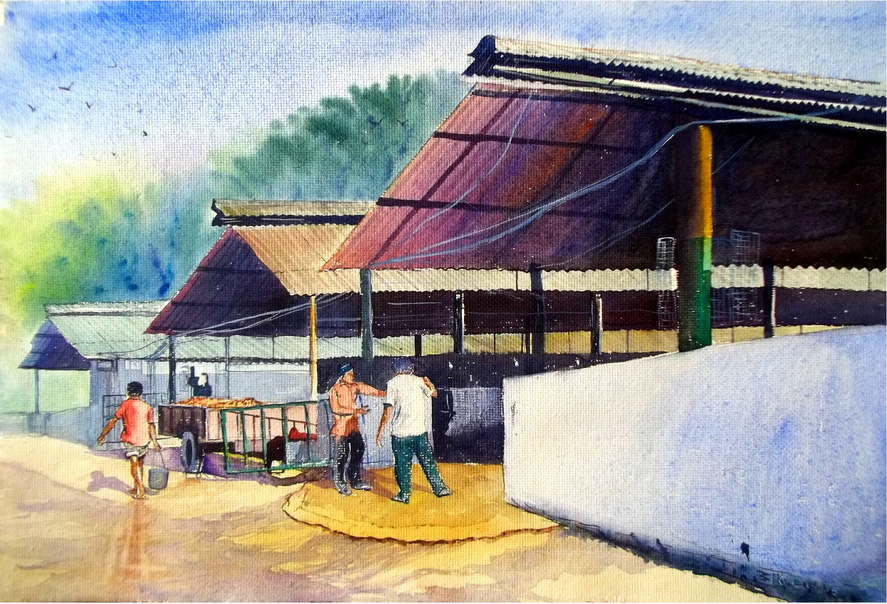
Landscape paintings represent the panoramic vision of the natural realm with the interpretations that influence the artist’s perspective. In an endeavour to symbolize the splendour that meets the eye, the painter makes an attempt to capture the transient moment in time and space, once and for all, thus becoming a co-inventor with the real Creator (God).
In these revelations, there are elements that can be natural or human mind creation. Flora and fauna, the weather conditions, dawn and dusk all can play a major role. From the perspective of the community there is the indescribable metamorphosis of the merely picturesque and the blending of the artist's own deep feeling and inspiration.
Landscape art has attributed greater significance to ancient works, portraits and genre representations and had emerged over centuries.
This blog attempts to take you through different eras when famous landscape paintings were created by distinguished artists and its evolution.
Sixteenth Century Landscape Paintings
During the 16th century, some renowned Northern artists including Joachim Patenier, Albrecht Altdorfer, Albrecht Durer and Pieter Bruegel created landscape paintings with greater liberation and enthusiasm. As a case in point, Bruegel came up with the masterpiece ‘Hunters in the Snow’ in 1565. Later in the year 1558, Bruegel painted Landscape with the Fall of Icarus which embraces stunning scenery only as background to the mythical message.
Seventeenth Century Landscape Paintings
In the face of the fact that numerous of superior quality and famous landscape paintings were created during 16th century, this form of artwork did not really come into full swing until the 17th century with the emergence of the Dutch and Flemish schools: covering artists such as Aelbert Cuyp, Jacob Van Ruisdael and Rubens. The paintings mainly comprised beautiful rustic landscapes as the backgrounds for religious subjects.
Before arrival of the 18th century, it's worth highlighting that the real difference between landscape as embellishment and landscape as an independent genre is not the manifestation of non-appearance of human figures, but somewhat their dimensions and purpose.
Eighteenth Century Landscape Paintings
Landscape art in the 18th century was mainly inspired by the general social and political climate of the prehistoric regimes in England, France and the remaining parts of Europe. New viewpoints to the natural surroundings appeared, and in England unique new topological customs came into being, replicating the practice of landscape propagation - the restructuring of nature to ensemble upper-class supporters and buyers. Picturesque paintings were still not considered as culminations in themselves. Rather they depicted the heavenly congruence of nature, and composed buoyancy in the existing climate of opulence.
Nineteenth Century Landscape Painting
After the catastrophic happenings of the French Revolution and the Napoleonic Wars, landscape artwork became one of the most widely known genres of art and quickly flourished into a foremost picturesque type for artists, buyers and collectors. In reality the 19th century was considered to the period in which the greatest landscapes painting had ever been seen. Two major customs arisen: English and French, both of which persuaded landscape painters all over Europe and North America, and had a huge bearing on the art of the era.
Twentieth Century Landscape Art
Landscape art of the 20th century evolved as a genre to a great extent owning to the number of art movements that came into being during this period. During this era, many renowned artists created striking piece of artwork, such as Charles Demuth, Charles Sheeler, and Ricard Estes, to name a few. Major focus was on the creation of urban landscapes with presence of industrial buildings.
In the meantime, land art/earth paintings and other types of environmental art have enabled artists to express their deep sentiments for nature's opulence and enormities. Therefore, while landscape painting remains prevalent and endures to entice interest from artists and art buyers equally. This is not astonishing. Most imaginative customs were completely defined distinctively, if not greatly influenced by Cubism, two world wars and the atomic bomb.
Landscape Painting in the Twenty-First Century
It remains unspecified how landscape art will develop in the present day and age. Will the demands and disciplines of Hypothetical art inspire reappearance of traditional, realistic canvases, or will the abstract art - encompassing figures and actions, as well as newest delivery approaches like video - persist to dominate? Answers to these questions can be known in the coming time only.
Indeed, there are many distinguished and upcoming artists who have been appreciated for creation of beautiful landscape artwork.
If you are looking for famous landscape paintings to decorate your living room wall, then do browse through our online art gallery.





















